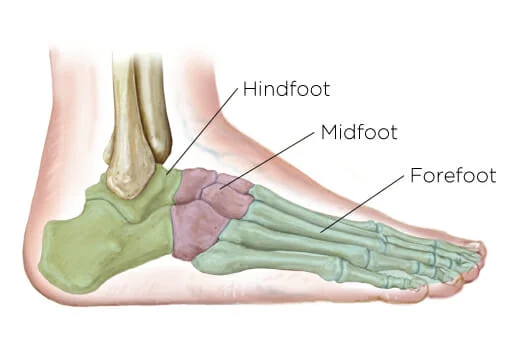Ankle Mobility for Athletes
Feb 10, 2025
Edited by: Danielle Abel
Ankle mobility is a term that’s often thrown around in fitness and rehab conversations, but what does it really mean? While it might sound simple, improving ankle mobility requires understanding its key components. Let’s break it down and explore how to improve this crucial aspect of movement.
What Is Ankle Mobility?
Ankle mobility refers to the ability of your ankle joint and surrounding structures to move effectively. This includes:
- Ankle dorsiflexion and plantarflexion: The up-and-down movement of the foot.
- Subtalar inversion and eversion: The tilting of the foot inward and outward.
- Forefoot mobilization: The flexibility and adaptability of the forefoot.

(Image credit: Braceworks Custom Orthotics)

(Image credit: Masterson Foot Clinic)
If your foot can move smoothly in all these directions and adjust to different surfaces, your ankle mobility is likely in good shape. But what if it’s not? Let’s dive deeper.
Ankle Dorsiflexion: The Foundation of Mobility
Ankle dorsiflexion occurs when you lift your toes closer to your shin, like stepping up onto a stair. This movement is essential for everyday activities such as walking, running, squatting, and climbing. Without sufficient dorsiflexion, these movements can feel restricted, awkward, or even painful.


You’ve probably seen stretches like those above promising to improve ankle mobility—like banded stretches or calf stretches with elevated toes. However, these often miss the mark. The true restriction for most people isn’t in the calf muscles or Achilles tendon but in a biomechanical misalignment at the subtalar joint (just below the ankle) and the forefoot. Addressing these areas can unlock your ankle mobility more effectively.
Decreasing Foot Stiffness: Subtalar Eversion & Forefoot Mobilization
The subtalar joint, located just above your heel, allows your foot to tilt inward (inversion) and outward (eversion). Subtalar eversion is critical for absorbing shock and maintaining balance during activities like walking, running, or navigating uneven terrain.
When subtalar eversion occurs, it flattens the forefoot, creating the necessary space for greater ankle dorsiflexion. Many mobility issues stem not from tight muscles but from bony misalignments in the foot. By mobilizing the subtalar joint and forefoot, you can unlock a greater range of motion and experience smoother, pain-free movement.
IMAGE
IMAGE
Exercises to Improve Ankle Dorsiflexion
Here are 3 effective drills to enhance ankle dorsiflexion while addressing subtalar and forefoot mechanics:

Ankle Dorsiflexion Drill with Subtalar Eversion on a Wedge (pictured above)
- How to Perform: Place a wedge or small plate under the outer half of your heel and perform a forward ankle dorsiflexion stretch (e.g., in a half-kneeling position). Hold for 1-2 minutes, pausing in the forward, flexed position.
- Why It Works: This drill allows the foot to change shape and improves range of motion by addressing rearfoot mechanics.
- Pro Tip: Test and retest your dorsiflexion before and after to see the improvement.

Forefoot Mobilization Drill on a Wedge (press into the area under the big toe as depicted above)
- How to Perform: Place a wedge or small plate under your big toe and perform a forward ankle dorsiflexion stretch (e.g., in a half-kneeling position). Hold for 1-2 minutes, pausing in the forward, flexed position.
- Why It Works: Adjusting force application to the foot helps the forefoot bones “get out of the way” of the tibia, improving range of motion.

Static Deep Squats on a Wedge (as depicted above)
- How to Perform: Place wedges under your heels and hold a deep squat position, either with body weight or added load (e.g., a barbell or weight above your knees). Hold for 1-2 minutes.
- Why It Works: Spending time in a dorsiflexed position builds capacity and trains your body to use its newly gained range of motion.
Ankle mobility is about more than just stretching tight calves. By addressing the subtalar joint, forefoot mechanics, and dorsiflexion limitations, you can unlock smoother, more efficient movement for your favorite activities.
Support & Courses Available
Ready to learn more about movement assessment & corrective exercise? Our course, Movement Assessment 101, teaches you a new, innovative approach to understanding human movement and performance, how to confidently address common sources of pain, and how to select corrective exercises that actually create lasting change. Click here for more info.
Stay connected with news and updates!
Join our mailing list to receive the latest news and updates from our team.
Don't worry, your information will not be shared.
We hate SPAM. We will never sell your information, for any reason.

